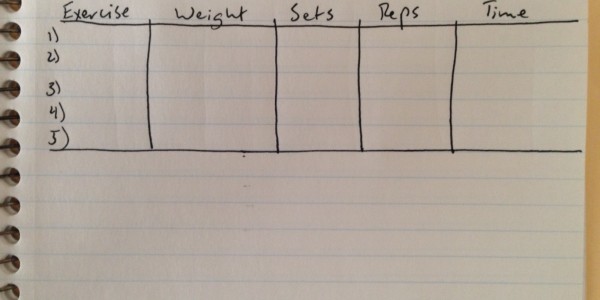The typical gym goer usually doesn’t track anything when they go to the gym. More often than not, their workout is made up on the spot. They perform the basic 3 sets of 10, and then call it a day.
They mix up exercises every now and then, and try to add weight when they can. All in all, its not a very effective approach to training. The results usually speak for themselves, and with a program like this, you probably won’t see much.
When results are slim, it can be hard to continue training. You may wonder why your are getting up early to go workout, with nothing to show for it.
Today, I want to share an idea with you that will get you better results while making your training a lot more fun.
In the first sentence of this article, I mentioned most people do not track anything when they go to the gym. This is the first place to start. Buy a notebook where you can write all of your workouts in.
The next step is actually tracking. This is where things get fun, and honestly you can track anything you want. The more you track, the higher your chance of seeing progress. Let me explain.
In your notebook, you can create 5 different columns like I did in the picture below. 
I’ve listed exercise, weight, sets, reps, and time (total time of completion for the exercise). So now we have 4 different variables to track during the session.
Now, let’s say you had back squats on this particular day, and your target is 3 sets of 3-5 reps. During this session, your sheet may look like this.
Exercise: Back Squat
Weight: 200
Sets: 3
Reps: 4, 4, 3
Time: 5:22
Since we have tracked this data, during the next session we just try to do a little bit better. That could be in one particular column like time or in multiple columns like reps and time.
This same day the following week could like this.
Exercise: Back Squat
Weight: 200
Sets: 3
Reps: 4, 4, 3
Time: 5:16
You’ll notice that there was a decrease in total time (5:22 to 5:16). That is an improvement from last time!
You did everything exactly the same but in less time. You only know this because you were tracking it.
Another thing I want to point out is the rep range. In the example above, my rep range was 3-5. In most programs, you see a fixed rep scheme (3 sets of 8 reps).
Creating a range will allow you more room to see improvement. If I set a range of 8-12 reps for 3 sets, my training log could look like this: 12 reps for the 1st set, 9 for the 2nd, and 9 for the 3rd. The next time it may be 12,10,9.
I would have done just 1 rep better, but its still 1 rep better!
If I used a standard rep scheme of 3 sets of 8 reps, it is much harder to increase to 3 sets of 10 (2 more reps on each set) than it is to shoot for 1 more total rep through all 3 sets.
Many think of progress only as how much weight they lift or how many reps they can perform. When you first start lifting weights, it’s easy to increase these variables. As you continue, this becomes much harder which can make training stagnant and boring.
That’s why having a system like this can make things a lot more exciting while providing more opportunities for progress.
Below are some of the examples of progression you could see when tracking your training:
1. Increase in weight
2. Decrease in sets with the same number of reps (going from 20 reps in 4 sets to 20 reps in 3 sets).
3. Increase in sets with more reps (going from 20 reps in 3 sets to 25 reps in 4 sets)
4. Increase in reps with less sets (going from 20 reps in 4 sets to 22 reps in 3 sets)
5. Increase in reps in the same number of sets (going from 20 reps in 4 sets to 22 reps in 3 sets)
6. Decrease in time (going from 5:22 to 5:18)
Tracking each session is important, but the key is to get a little bit better each time. And if you keep getting a little bit better and a little bit better, you will see your results dramatically increase.






